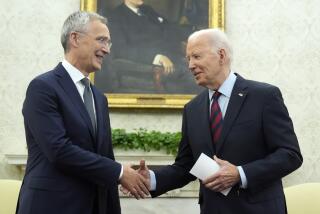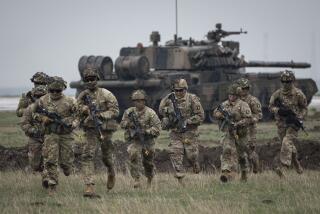East Bloc Reveals Troop Strength Data : Figures Show ‘Rough Parity’ With NATO, Warsaw Pact Reports
MOSCOW — In a move that Western analysts here said has more political than practical importance, the Soviet-led Warsaw Pact nations published Monday for the first time detailed data on their military forces in Europe and their estimates of NATO forces.
East Bloc defense ministers said in an accompanying statement that the data shows “rough parity” between the two sides. The statement said the information was intended to counter estimates by the North Atlantic Treaty Organization, made public last November, which suggested that the Warsaw Pact countries have an overwhelming advantage in conventional arms.
The East Bloc figures show a concentration of Warsaw Pact manpower and weaponry in Europe that in many categories is even greater than NATO had estimated. But they imply that NATO under-reported its own military strength by an even greater margin.
Because of different ways of calculating and classifying forces and weapons, it may be some time before definitive comparisons are possible.
“I’m assuming there are thousands of green eyeshades in the Pentagon and similar places right now sorting through the data,” a Western military attache here said.
For now, he said: “I think the importance of the document is that it represents the first time they have come forward with any kind of comprehensive data at all on Warsaw Pact capability. To the extent they’ve now laid something on the table, that represents a change.”
Full Page in Pravda
The statistics and accompanying statement by Warsaw Pact defense ministers took up an entire page in Monday’s issue of Pravda, the newspaper of the Soviet Communist Party. Their publication fulfilled a promise by Soviet Foreign Minister Eduard A. Shevardnadze earlier this month in a speech before the concluding session of the Conference on Security and Cooperation in Europe.
Publication of the data comes slightly more than a month before the scheduled opening of a new round of East-West conventional arms reduction talks scheduled to begin in Vienna on March 9, but a senior European diplomat here said it will probably not be crucial to those talks.
NATO, he said, was once interested in establishing a statistical base line for such negotiations but has more recently emphasized the need to agree on limits for various categories of men and arms and ways of verifying that the limits are honored.
Moscow, too, now appears eager to get past the numbers hurdle that kept previous negotiations--the Mutual and Balanced Forces Reduction talks--stalled for most of their 15-year duration.
Shevardnadze said in his Jan. 18 speech that the Soviets “do not ignore the importance of initial data” but that “figures should not become an obstacle to politics. Long and fruitless discussions on categories of armaments and methods for counting troops may clog up the talks.”
Pressure for Reciprocity
Still, publication of the figures does appear to be intended to increase the pressure on NATO for some reciprocal action to match what amounts to a Soviet peace offensive in Europe.
It follows the announcement in recent weeks of a series of unilateral troop and armament reductions to be carried out by the Soviet Union and its East Bloc allies over the next two years. They include a 500,000-man cut that is to reduce the size of the Soviet army by more than 10% and the withdrawal from Eastern Europe of six Soviet tank divisions.
In their statement Monday, the Warsaw Pact defense ministers urged the West to “demonstrate a similar readiness to make early headway to stronger stability and security in Europe, including unilateral measures to reduce their armed forces and armaments.”
The Soviet moves have caused a certain strain within the Western alliance, between countries like the United States and Britain, which welcome the East Bloc actions but say they want to see more, and others, like West Germany, which advocate a more positive response.
Washington and London are particularly concerned that the Warsaw Pact moves are eroding support for plans to modernize NATO’s tactical nuclear forces in West Germany. They argue that NATO needs modern, short-range nuclear weapons as a last resort to stop an otherwise indefensible, all-out East Bloc ground assault.
The Warsaw Pact figures acknowledge a significant East Bloc advantage over NATO in such important weapons categories as tanks, other armored combat vehicles and artillery. They put East Bloc tank strength even greater than NATO estimates (59,500 vs. 51,500) and admit to having nearly 65% more artillery than NATO’s study (71,600 vs. 43,400).
But the East Bloc figures show NATO with a significant advantage in ground support aircraft, combat helicopters and anti-tank weapons.
They estimate virtual equality in manpower, with 3.6 million troops in and around Europe for the Warsaw Pact powers and 3.7 million for NATO. NATO had previously put the totals at 3.1 million for the Warsaw Pact vs. 2.2 million for the West. The difference between the two sets of figures is due chiefly, though not entirely, to the fact that the Warsaw Pact includes navy and air force personnel in its calculations; NATO does not.
“Armed forces are an integral organism,” the East Bloc defense ministers said. “Its components--the ground forces, the air forces, the air defense forces, and the navy--interact with one another and complement and reinforce one another. It is only by analyzing them as a package that it is possible to assess the real correlation of the sides’ forces.”
Many of the differences between the NATO and Warsaw Pact figures are simply a matter of how each side chooses to count men and weaponry to best make its own case.
Since NATO has about twice as many navy personnel in and around Europe as does the Warsaw Pact, for example, including this personnel helps buttress the East Bloc’s argument that forces are in approximate balance.
Gun Size a Factor
NATO includes in its artillery count 100-millimeter guns and larger weapons; Warsaw Pact figures include 75-millimeter guns and larger weapons. Since NATO happens to have a much greater supply of guns in the 75- to 100-millimeter category, the difference has a major impact on the comparison.
The two sides also count tanks differently. NATO includes in its figures only main battle tanks, while the Warsaw Pact includes smaller tanks that the West places in a different weapons category.
“It’s too early to say the (Warsaw Pact) numbers are put forth in good faith,” a Western military attache here said, “but it’s also too early to rule out that possibility.”
This attache emphasized that however inaccurate the specific numbers may turn out to be, the East Bloc’s assessment of NATO strength is in some ways as important as its statement of its own.
“It’s important for each side to understand the perspective of the other vis-a-vis the balance,” he said.
The East Bloc defense ministers said their figures prove that “the military balance in Europe, considering all its ingredients, can be described as a rough parity which does not give a possibility to either side to count on a decisive military advantage.”
MILITARY STRENGTH IN EUROPE--WARSAW PACT AND NATO
Warsaw Pact Figures NATO Fi Warsaw Pact NATO Warsaw Pact Total personnel 3,573,100 3,660,230 3,090,000 Combat aircraft 10,659 11,205 8,250 Helicopters 2,785 5,270 3,700 Tanks 59,470 30,690 51,500 Anti-tank weapons 11,465 18,070 44,200 Armored personnel carriers 70,330 46,990 71,000 Rocket launchers, artillery, mortars** 71,560 57,060 43,400
gures* NATO Total personnel 2,213,593 Combat aircraft 3,977 Helicopters 2,419 Tanks 16,424 Anti-tank weapons 18,240 Armored personnel carriers 35,351 Rocket launchers, artillery, mortars** 14,458
Warsaw Pact countries: Bulgaria, Czechoslovakia, East Germany, Hungary, Poland, Romania and the Soviet Union. NATO alliance: Belgium, Britain, Canada, Denmark, France, West Germany, Greece, Iceland, Italy, Luxembourg, Netherlands, Norway, Portugal, Spain, Turkey and the United States.
* NATO figures exclude naval and air force personnel
** Warsaw Pact reports 75-millimeter guns and larger, NATO 100-millimeter and larger
More to Read
Sign up for Essential California
The most important California stories and recommendations in your inbox every morning.
You may occasionally receive promotional content from the Los Angeles Times.










